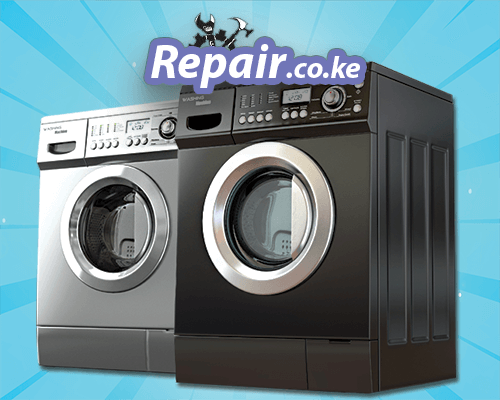How Washing Machine Repair is Done
If you are wondering how Appliance repair Technicians get washing machine repair in Nairobi done, we have compiled a list of steps to the results, and the common washing machine problems that usually get fixed. Hang on and continue reading this informative piece.
The modern washing machine is a marvel of engineering, simplifying a once labor-intensive chore into a convenient, time-saving process. However, like any complex appliance, washing machines are prone to wear and tear over time, and breakdowns can be frustrating. That’s where washing machine repair comes in. In this article, we’ll take you through the steps involved in repairing a washing machine, shedding light on the processes that can save you from the hassle and cost of replacing your trusty appliance.
1. Initial Diagnosis
The first step in washing machine repair is identifying the problem. Often, this involves talking to the owner and understanding the symptoms the machine is exhibiting. Common issues include failure to start, excessive noise, leaking, or improper cleaning. Experienced technicians can often make an educated guess about the problem based on these descriptions.
2. Visual Inspection
Once on-site, the technician will conduct a visual inspection of the machine. This involves checking for obvious issues like loose wires, disconnected hoses, or visible damage to components. Sometimes, the problem is apparent at this stage, and a quick fix can resolve it.
3. Testing and Diagnosis
If the issue isn’t immediately apparent, the technician will move on to testing various components of the washing machine. This includes checking the electrical connections, running diagnostic tests on the control board (if applicable), and examining critical parts like the motor, pump, and agitator. This stage may involve using specialized equipment to identify the exact fault.
4. Replacement of Faulty Parts
Once the problem is pinpointed, the next step in washing machine repair is replacing any faulty components. This could involve replacing a malfunctioning motor, a damaged drum bearing, a worn-out belt, or a defective control board, depending on the issue. Experienced technicians will use manufacturer-approved replacement parts to ensure the appliance’s reliability.
5. Reassembly
After replacing the damaged or worn components, the technician will reassemble the washing machine. This step is crucial to ensure that all parts are properly connected and aligned, preventing future issues.
6. Testing
With the washing machine reassembled, the technician will run a series of tests to ensure that the problem has been resolved. This involves running a test cycle to check for any unusual noises, leaks, or operational issues. The technician will also verify that the machine is functioning according to the manufacturer’s specifications.
7. Cleaning and Maintenance
A professional washing machine repair service often goes the extra mile by cleaning and performing routine maintenance on the machine. This can include cleaning filters, removing lint buildup, and lubricating moving parts. Regular maintenance can extend the life of your washing machine and prevent future problems.
8. Final Check and Recommendations

Before leaving, the technician will conduct a final check to ensure the washing machine is functioning correctly. They will also provide recommendations for proper use and maintenance to prevent future issues. This might include advice on loading the machine, using the right detergents, and scheduling routine maintenance.
Washing machine repair is a process that involves a combination of technical expertise, diagnostic tools, and genuine replacement parts. Professional technicians are equipped to handle a wide range of washing machine problems, from minor issues like loose wires to more complex problems like motor or control board replacements. By entrusting your washing machine repair to experienced professionals, you can extend the life of your appliance, save money on replacements, and enjoy the convenience of a well-functioning washing machine for years to come.
Common Washing Machine Problems that Technicians will Fix in Nairobi
Common Washing Machine Problems: Causes, Solutions, and Prevention

Washing machines have become indispensable appliances in modern households, saving us time and effort in our laundry routines. However, like any complex machinery, washing machines are susceptible to various problems that can disrupt their smooth operation. In this technical informative article, we will delve into some common washing machine problems, explore their causes, provide practical solutions, and offer tips on prevention to ensure your washing machine continues to serve you effectively.
1. Problem: Washer Won’t Start
Cause: Several factors can prevent your washing machine from starting. It could be due to power issues, a malfunctioning door switch, or a faulty control board.
Solution:
- Check if the power cord is properly plugged in and that the outlet is functioning.
- Ensure the door is securely closed. If not, the door switch may need replacement.
- If neither of these steps works, consult a professional for control board diagnostics and repair.
Prevention: Regularly inspect and maintain power cords, outlets, and door mechanisms to avoid unexpected start-up issues.
2. Problem: Excessive Noise During Operation
Cause: Unusual noise during washing cycles can be attributed to loose or damaged components, foreign objects in the drum, or worn-out drum bearings.
Solution:
- Ensure the machine is level on the floor to prevent excessive vibrations.
- Inspect the drum for foreign objects like coins, keys, or small clothing items.
- If noise persists, consult a professional to replace worn-out drum bearings or other damaged components.
Prevention: Avoid overloading the machine and routinely inspect the drum for foreign objects to prevent damage.
3. Problem: Leaking Water
Cause: Water leaks can result from damaged hoses, a clogged drain pump, or overloading the machine.
Solution:
- Inspect hoses for cracks or leaks and replace them if necessary.
- Clean the drain pump filter to remove debris.
- Avoid overloading the machine to prevent strain on seals and gaskets.
- Consult a professional if leaks persist, as it may involve complex issues like a faulty water inlet valve.
Prevention: Regularly check hoses, clean filters, and be mindful of load sizes to prevent water leakage.
4. Problem: Clothes Remain Dirty After a Wash
Cause: Inadequate cleaning can occur due to improper detergent usage, a clogged detergent dispenser, or worn-out agitators or impellers.
Solution:
- Follow detergent usage guidelines provided by the manufacturer.
- Clean the detergent dispenser regularly and ensure it’s not clogged.
- If the issue continues, have a professional inspect and possibly replace damaged agitators or impellers.
Prevention: Use the correct detergent amount, clean the dispenser, and avoid overloading to ensure thorough cleaning.
5. Problem: Machine Doesn’t Drain Properly
Cause: Poor drainage can result from a clogged drain hose or pump, a malfunctioning drain pump, or blocked filters.
Solution:
- Check for blockages in the drain hose and pump, clearing any debris.
- Clean filters to ensure proper drainage.
- Consult a professional if the issue persists to address complex problems like a faulty drain pump.
Prevention: Regularly clean filters and check for obstructions in the drain system to prevent drainage issues.
While washing machines offer convenience, they can encounter common problems that require attention. Understanding the causes and solutions for these issues is crucial for effective troubleshooting. Regular maintenance and prudent usage can help prevent many of these problems and extend the life of your washing machine, ensuring it continues to provide efficient and hassle-free laundry solutions.
